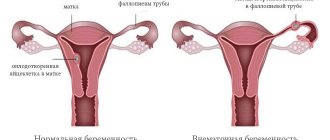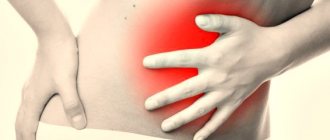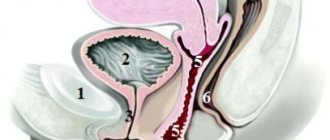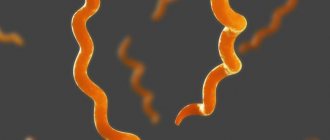Causes of early miscarriage
Miscarriage in the first trimester of pregnancy is quite common. It causes pain in the lower abdomen and bleeding. Doctors often do not give a direct answer to the question of the cause of this pathological phenomenon in an individual case. In a general sense, this may be due to genetic mutations in the fetus that are incompatible with life. The body seems to reject a fetus with chromosomal abnormalities. But this doesn't always happen.
Genetic abnormalities and disorders
This factor arises due to the fact that one of the parents passes on a chromosome or several chromosomes that have a mutating gene. As a result, the formation of organs and organ systems does not occur according to the script, which is why the body gets rid of the fetus. Such deviations most often arise as a result of the action of radiation or hazardous waste on the genome. Harmful industries (working with mercury, processing titanium and rare earth metals, producing household chemicals, etc.) can also increase the chance.
Which miscarriage is considered early?
Early miscarriage is characterized by spontaneous termination of pregnancy for up to 12 weeks. According to statistics, about 15-20% of pregnancies end in just such an interruption. This is the most common pathological condition in obstetrics and gynecology. About a third of cases occur at 8 obstetric weeks. Mothers over the age of 40 are at risk for early miscarriages. This is due to the frequency of abnormalities in the fetal chromosomes, which are the causes of more than 50% of pathological conditions - miscarriages.
Probability of miscarriage by week of pregnancy and causes of pathology at different stages
In the 1st trimester of pregnancy, a woman should be especially careful.
This period is considered by doctors to be the most difficult, as the formation of the organs of the future baby occurs. The placenta, which forms by the middle of the first trimester, protects the fetus. During the period of its appearance, the fetus is especially vulnerable: for this reason, a woman should not smoke, she should give up alcohol, lead an active lifestyle, and spend more time in the air. In the first trimester, experts identify three dangerous periods:
- Duration from 2 to 3 weeks. The fertilized egg is sent to the walls of the uterus in order to attach to them.
The causes of miscarriage during this period may be:
- nervousness, depression, stress;
- physical exercise;
- alcohol, nicotine, drugs;
- pathologies in fetal development;
- myoma;
- endometriosis.
- Duration 4-6 weeks. At this time, the fetus begins to form systems and organs of the body. The danger may be the development of fetal abnormalities.
The causes of miscarriage can be:
- inflammation in the pelvic organs;
- unhealthy lifestyle of women;
- emotional overload.
- Duration from 8-12 weeks. At this moment, the baby’s main defense is formed. This is the placenta. Hormonal imbalances in a pregnant woman's body can affect the structure of the placenta and the development of the fetus. In addition to hormonal pathologies, other pathologies lead to the death of the fetus in the womb.
Symptoms of danger in the first weeks of pregnancy
Since pregnancy is early, a miscarriage can be confused with the resumption of menstruation. With one caveat: they will be abundant. If a woman knows that she is pregnant, she should immediately consult a doctor. Typically, pathological pregnancy is accompanied by pain in the lower abdomen. Even after an early spontaneous abortion, cleaning may be necessary.
Symptoms of danger in the second trimester
- pulling pain in the lower abdomen;
- hypertonicity of the uterus (permanent and temporary);
- formation of bloody discharge;
- the cervix is open.
What is the likelihood of miscarriage in the third trimester?
If a spontaneous abortion occurs between 23 and 37 weeks, doctors call it preterm labor.
If the baby is born between 37 and 42 weeks, it is called delivery. This is the absolute norm, since at this time a completely healthy baby is born. If a woman gives birth after 42 weeks, then this is not very good for the baby. If a woman gives birth before 22 weeks, she is essentially a fetus. If its appearance occurs from 22 to 37 weeks, then the baby is considered premature. Depending on the period (23, 24, 25 weeks, etc.), babies have different heights and weights. They are cared for in special departments for premature babies. The danger of the third trimester is bleeding. The causes of this phenomenon are placental insufficiency and placenta previa. In many cases, premature placental abruption will not harm the woman. But a complication may occur: bleeding, in which it is necessary to call a doctor.
In addition, it happens that children die in the womb due to entanglement in the umbilical cord. If there have been no kicks from the baby for a long time, the mother has stopped feeling them, it is better to go to the doctor. In addition, in the third trimester, leakage of amniotic fluid is dangerous. This can lead to hypoxia of the baby, and as a consequence of this process, suffocation. In this difficult situation, doctors stimulate premature birth. This is done with the help of special drugs. The same manipulations are performed if the amniotic fluid has already leaked out, and the woman cannot give birth within 20 hours. Induction of labor begins.
The reasons for early delivery in the period from 28 to 32 weeks lie in placental abruption, toxicosis, and hormonal imbalance.
At what stage does miscarriage most often occur?
In most cases, spontaneous abortion occurs early.
A woman may not even know that she is pregnant, since a miscarriage after 2 weeks may not cause any symptoms. In the early stages, if we summarize all the available reasons, a miscarriage occurs:
- Genetic abnormalities of the fetus. Geneticists believe that approximately 70% of spontaneous abortions occur due to such anomalies. But most often they are random, that is, they can be triggered by a viral disease or radiation.
- Hormonal disorders in the body, in particular progesterone deficiency. Or vice versa: a woman’s body contains a lot of male hormones that negatively affect the synthesis of estrogen and progesterone.
- Rhesus conflict. This conflict arises when the Rh factors of the partners are different. In this case, the mother’s body does not accept the fetus, thinking that it is a foreign body.
- Infectious diseases of women. For example, these are infections such as syphilis, gonorrhea, herpes, and toxoplasmosis.
- Chronic diseases of pregnant women. In addition, infections: rubella, influenza.
- Abortion. Their consequence is an inflammatory process, ovarian dysfunction. These phenomena disrupt the normal course of pregnancy.
- Use of medications prohibited for pregnant women.
- Nervous situations.
- Physical exercise.
- Injuries.
- Bad habits: alcoholism, smoking, drugs.
Timing of self-abortion
Early pregnancy loss most often occurs before the 13th gestational week. If the pregnancy is terminated at 4–5 weeks, the woman perceives the miscarriage as more painful and heavy periods.
It is believed that the maximum risk of losing a child in the early stages awaits the expectant mother:
- At 4 weeks.
- At 8 weeks.
- At 12 weeks.
From the 13th to 20th gestational week there is a risk of fetal loss due to the development of ICM. At this stage, termination of pregnancy already proceeds similar to early labor, with the discharge of amniotic fluid and the expulsion of the embryo. By this time, the fetus has completed the formation of its main organs and has clearly distinguishable individual facial features.
Many women ask: “Will I get pregnant and how soon after a medical abortion or self-abortion in the first gestational weeks?” Doctors usually recommend saving the first pregnancy, because post-abortion infertility is not uncommon in obstetric practice. Nevertheless, many women repeatedly and successfully conceive offspring after medical abortion or spontaneous termination of the gestation process.
You can get pregnant after a medical abortion within 1.5–2 weeks. Therefore, it is advisable to take care of contraceptive methods in a timely manner.
How does spontaneous miscarriage occur?
If there is an early miscarriage, bleeding begins with aching pain in the lower abdomen.
Gradually the bleeding increases. A woman has a chance to continue her pregnancy if the discharge is light. Otherwise, with severe bleeding there is almost no chance, especially if the blood flows out with clots.
Uterine tone may be a sign of threat. This is worth remembering, even if a woman does not have any discomfort in the lower abdomen. They are expressed in nagging pain of low intensity. But usually the tone of the uterus is manifested quite clearly, precisely by this nature of pain.
In any trimester, the signs of miscarriage are similar. Only the intensity of pain and discharge can be different. In the second trimester, injury to the sac containing amniotic fluid may occur. As a result, the woman feels fluid leaking from her vagina and pain when urinating.
First aid for threatened miscarriage
If a woman realizes that she is having a miscarriage (pain and bleeding appear), she should immediately call an ambulance. She will be given first aid and urgently hospitalized. It is important to make sure that parts of the fertilized egg are not retained in the uterine cavity. In this case, the bleeding will only intensify, which can lead to the death of the woman herself.
Until the ambulance arrives, you should take a horizontal position, drink as much water as possible and put something cold on the lower abdomen for 15 - 20 minutes. If the discharge is profuse, it cannot be stopped, it is necessary to compress the abdominal aorta by pressing the suprapubic part with your fist and as much as possible bring it closer to the spine. This can only be done in the early stages of pregnancy.
Consequences of miscarriage
If the miscarriage occurs early, for example, within 2 weeks, then there should be no complications.
But if a spontaneous abortion occurs at a later date, for example, at 8-9 weeks, the woman will need curettage. This procedure is already fraught with complications. They can occur due to the inflammatory process that occurs after curettage. Inflammation is treated with antibiotics (injections), physiotherapy, and then a follow-up ultrasound is required. But it is not always possible to overcome inflammation; it becomes chronic. As a consequence of this process, adhesions are formed. All this leads to infertility.
In the early stages
If curettage is not required, spontaneous abortion occurs without complications. Of course, not counting the moral and psychological state of the woman. During this period, she especially needs the support of loved ones.
In the later stages
Here the threat of spontaneous abortion applies to the baby. Despite the fact that doctors currently know how to care for premature babies, no one excludes the risk of their mortality.
Stages and symptoms of miscarriage
Doctors usually distinguish 4 stages of fetal rejection, each of which has its own specific symptoms.
- The first stage of the pathological process is characterized by an acute threat of miscarriage. The woman begins to experience aching pain in the groin and lower back. That's when she notices bloody discharge on her underwear. These manifestations are a direct indication for visiting a gynecologist or calling an ambulance. A patient with the above symptoms may be placed on “conservation” for the entire duration of pregnancy.
- The second stage is the immediate beginning of embryo rejection. The pain intensifies and becomes cramping. The patient experiences increased vaginal discharge while walking. She begins to complain of dizziness and weakness. During this period, the chances of saving the baby remain if medical assistance is provided on time and the woman is hospitalized.
- The death of the embryo is noted at the third stage, which is the miscarriage itself. The patient suffers from unbearable pain in the abdomen and lower back. The bleeding is very heavy.
- The fourth stage is the expulsion of the fetus and its membranes from the uterine cavity. Abortion is accompanied by contraction of the uterus, after which the bleeding subsides. Sometimes not all parts of the embryo leave the mother's body, then this condition is called an incomplete miscarriage. In this case, they resort to surgery to remove the remains of the fetus.
In any case, the diagnosis of “complete miscarriage” must be confirmed by ultrasound data.
During pregnancy, a woman may experience a so-called “frozen pregnancy.” The patient will be worried about such minor signs as dizziness and spots before the eyes.
The usual symptoms of pregnancy (toxicosis, breast tenderness) disappear. At this time, against the background of “hidden” symptoms, the embryo dies. This condition is extremely dangerous for the health and life of a woman. Therefore, there is a need for surgical intervention: curettage of the dead fetus with its membranes from the uterus.
When can you get pregnant after a miscarriage?
For many women, pregnancy after a miscarriage occurs within 3 to 12 months.
If the spontaneous abortion was not complicated by anything, then the likelihood of a successful completion of the pregnancy increases significantly. If a woman is healthy, she can become pregnant within a month after a spontaneous abortion. Pregnancy may be prolonged as the woman may experience menstrual irregularities. Doctors advise allowing the body to recover, that is, protecting against pregnancy for six months. In some cases, a woman must undergo a rehabilitation course. If after it a woman cannot conceive a child within a year, she should consult a doctor for examination.
Recovery period
Experts do not advise women to immediately become pregnant after a miscarriage. They voice the minimum period when the body is again ready for testing. It ranges from 3 to 6 months, it all depends on the condition of the female body, as well as the causes of the miscarriage. If the curettage procedure after a miscarriage occurs with complications for the woman, then you should wait at least six months for conception.
If the pregnancy ends in failure, then it is logical that when planning a second one you need to be examined by specialists. In particular, get tested:
- hormones;
- karyotype;
- tests for STIs, etc.
In addition, you need to be tested for infectious diseases:
- chlamydia;
- gonococci;
- candidiasis;
- herpes;
- mycoplasma, etc.
To identify pathogenic microorganisms, it is necessary to take a culture from the cervical canal, as well as a smear from the urethra. Doctors also recommend testing for antibodies to infections such as rubella and toxoplasma. They are determined by ELISA using blood sampling from veins.
Hormone tests are mandatory for those women who have problems bearing a child. That is, those who have had a miscarriage not for the first time. Sex hormones are administered according to certain rules: on days 1-3 of the menstrual cycle, in the morning, on an empty stomach. An exception to these rules is the procedure for donating the hormone progesterone. It is given on days 21-22 of the cycle. Other hormones are also tested according to indications.
All these medical procedures are part of the recovery period for women who have experienced spontaneous abortion in the early and late stages.
Also, the recovery period is characterized by compliance with simple rules:
- A woman's refusal to have sex for 2 months.
- Maintain a healthy lifestyle: moderate exercise, nutrition.
- Healthy and sound sleep.
- Lack of emotional overload.
- Undergoing a full body examination. Moreover, this should be done not only by a woman, but also by a man.
A miscarriage is a spontaneous termination of pregnancy.
Early miscarriage occurs before 12 weeks. If this episode is isolated in nature, then it is recognized as a random occurrence. If a woman has several miscarriages in a row, experts diagnose miscarriage. The causes of miscarriage, as well as chronic miscarriage, need to be known. Basically, the second case is associated with weakness of the cervix, as a consequence of multiple abortions. A single miscarriage is also accompanied by certain reasons indicated in the article. But if they are excluded, as well as adequate treatment, a woman has a high probability of giving birth to a healthy and strong baby.











